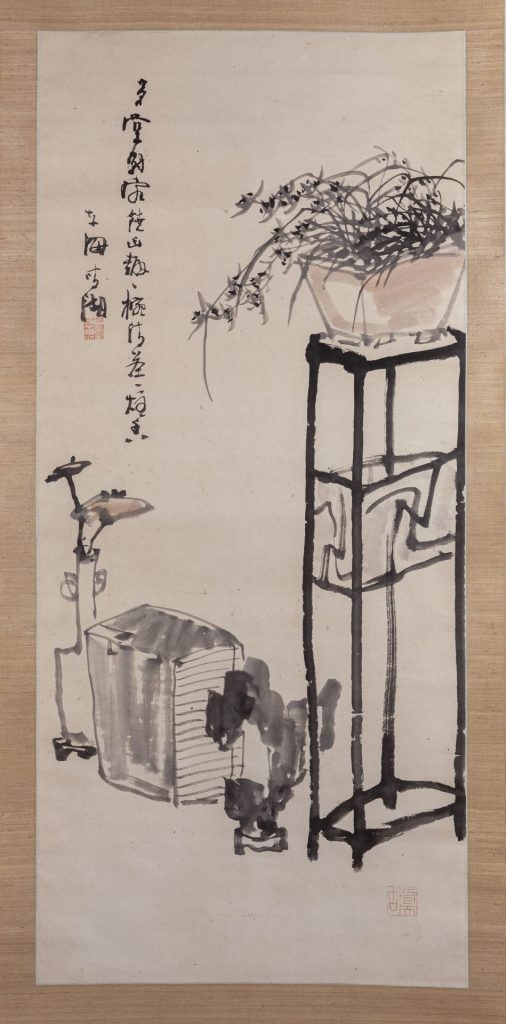
Okuhara Seiko (Japanese, 1837–1913), Scholar’s Objects, c. 1865–75. Ink and light color on paper, 53 x 23 ¾ inches. Museum Purchase, George S. Frierson, Jr., Fund, 2000.178
In this work, by Okuhara Seiko (Japanese, 1837–1913), an orchid in full bloom sits atop a wooden plant stand—a “scholar’s rock” at its feet adjacent to a stack of traditionally bound books and a Chinese-style vase holding an ornamental reishi mushroom. The objects are closely associated with the furnishings and decor of a scholar’s study, and represent—individually and in the aggregate—a scholar’s intellectual curiosity and taste.
Both the style and subject of this work reference a tradition and set of aesthetic principles that were a thousand years old at the time Seiko picked up her brush. The “literati” ideal dates to the Tang and Song dynasties in China (618-907 and 960-1279, respectively), when the court implemented meritocratic civil examinations for the selection of bureaucratic officials. These exams required an extensive knowledge of the writings of Confucius and covered literature, history, poetry, and calligraphy. Through the centuries, the scholarly elite that was created through this system developed a highly influential aesthetic that came to dominate cultural life in China. This tradition valued the personal expression of an individual’s learning and cultivation through their poetry, painting, and calligraphy over demonstrable skill. This ideal of the cultivated “amateur” scholar/artist (many Chinese painters who promoted this style of painting did in fact make their living from their art) became extremely popular in Japan in the 18th century, giving rise to what is called literati, or bunjinga or nanga-style, painting.
One of the most celebrated and successful bunjinga, or literati-style artists of the Meiji era (1868-1912) was Okuhara Seiko. Seiko fully inhabited the life of a literatus. The daughter of a high-ranking samurai, she was educated in Chinese history, literature, poetry, and philosophy—core subjects for a classical education at the time. Additionally, she became proficient in the martial arts and studied painting and calligraphy from an early age. Establishing herself in Edo (now Tokyo) at the age of 28, she quickly became associated with like-minded scholars and artists.
On a cultural level, Seiko fully inhabited the life of a literatus, deeply immersing herself in a world of scholarship and erudition while simultaneously building her social standing through friendships with powerful art patrons and politicians. She flourished in Edo, and as her fame grew, she began to receive requests to accept students. Over time, she expanded her home to accommodate a school for a reported 300 pupils that included a dormitory for her female students. (Male students had to commute.)
Seiko’s success within the male-dominated Edo art world was unusual for her time. Equally unusual was her unconventional self-presentation. Surviving photographs record her attired in men’s clothing, her hair closely cropped, as was common for men after the government’s abolition of the topknot in 1871. At least once during the height of her professional career, her identity as a woman was physically challenged; she was assaulted at an exhibition opening by another guest. Outraged, Seiko reportedly deployed her martial arts training and threw him to the ground.
Seiko’s contemporaries frequently commented on her “masculine” appearance, and drew connections between her outward appearance and her strong and confident brushwork. Today she is celebrated as a revolutionary feminist artist, and serves for many as a LGBTQIA+ pioneer. How Seiko would have chosen to identify herself remains an open question. Terms that are in common currency today did not exist during the Meiji period. She left no writings indicating her preferences, nor did her numerous students record her thoughts. Perhaps the greatest clue is her name, Seiko, which she adopted in 1865; it is gender neutral.
What is certain is that Seiko was able to live life on her own terms, without regard to societal expectations or norms. Her mid-century move to Edo, and her tremendous success there, was followed by an abrupt move in the 1980s to the countryside. There, she established her home and studio, and fully embraced her new identity as a hermit-recluse.
—Lisa Rotondo-McCord, Deputy Director for Curatorial/Curator of Asian Art
NOMA is committed to uniting, inspiring, and engaging diverse communities and cultures through the arts — now more than ever. Your gift will make a direct and immediate impact as NOMA welcomes our community back to the museum and sculpture garden, plans new exhibitions, and develops virtual and at-home arts education resources for school partners.
